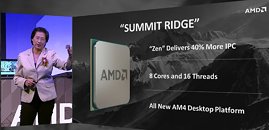Thursday, June 2nd 2016

AMD Confirms Key "Summit Ridge" Specs
AMD CEO Lisa Su, speaking at the company's Computex reveal held up the most important CPU product for the company, the new eight-core "Summit Ridge" processor. A posterboy of the company's new "Zen" micro-architecture, "Summit Ridge" is an eight-core processor with SMT enabling 16 threads for the OS to deal with, a massive 40% IPC increase over the current "Excavator" architecture, and a new platform based around the AM4 socket.
The AM4 socket sees AMD completely relocate the core-logic (chipset) to the processor's die. Socket AM4 motherboards won't have any chipset on them. This also means that the processor has an integrated PCI-Express gen 3.0 root complex, besides the DDR4 integrated memory controller. With the chipset being completely integrated, connectivity such as USB and SATA will be routed out of the processor. The AM4 socket is shared with another kind of products, the "Bristol Ridge" APU, which features "Excavator" CPU cores and a 512-SP GCN 1.2 iGPU.
The AM4 socket sees AMD completely relocate the core-logic (chipset) to the processor's die. Socket AM4 motherboards won't have any chipset on them. This also means that the processor has an integrated PCI-Express gen 3.0 root complex, besides the DDR4 integrated memory controller. With the chipset being completely integrated, connectivity such as USB and SATA will be routed out of the processor. The AM4 socket is shared with another kind of products, the "Bristol Ridge" APU, which features "Excavator" CPU cores and a 512-SP GCN 1.2 iGPU.

132 Comments on AMD Confirms Key "Summit Ridge" Specs
Sorry cant find anything usefull on overheating VRM's.
That well known problem is the relatively lose connection between heatsink and vrm, and that sticky pad in between. If you want to improve it's contact, make sure to tighten it up with even screws.
Your 1055t has a 125w tdp. It has never drawn 125w's in its life. The fx chips changed that they draw 200+ watt without even batting an eye.
Encoding using FMA was amazing.
I may never get beyond 5.1GHz at this point because if Zen is what it needs to be the board,chip,ram,cooler are going into my wifes new rig to upgrade from an ancient p4
ECS-P4VXMS
Asus-P4S8X- board had compatibility issues with GPUs, needed a beta bios and a certain setting turned off.
MSI-NF2
DFI-NF2
Asus-SBTR2990FX
So far it's bin the best oc'ing AM3+ motherboard in my experience, from a single-core sempron all the way up to 4.1GHz on a condensor running at -25 stressed with no issues. It boots up a HTT of over 340MHz which is crazy compared to other boards and best for CPU's with a locked MP.Yeah there you have it. Your bad experience ofcourse suits all Crosshair IV motherboards thus being crap. I think you blew it up because you did some things wrong there buddy.
ECS K7S5A-pro-bad caps
MSI K7N2 Delta-bad caps
Machspeed K8M8MS-still works to this day
MSI K9A2 Platinum-blew a PCI-e slot and then eventually just died
Asus Crosshair II-no issues
Asus M4A78T-E-one of my favorite boards of all time. Blew mosfets on about 6 of them under DICe
Asus Crosshair III-still running a 1035T based rig for my folks
Asus Crosshair IV-blew one under cold
MSI 890FXA-GD65-still runnning an FX 4130 to this day
Asus Crosshair V-still running a 9370 to this day
Watercooled you can hit that with a regor core and a crosshair IV-F mind you that was the "gamer" board of the series and the extreme was the one aimed purely at overclocking. Hence the no fluff design
Correctly the 390 or 970 are both competitive FpS depending on the game, while a 390 at 1440p might provide a slight advantage in its' available memory. That's said in the actual building of a system, the extra 30% need to move up from a 390 (20% from a 970 of $320ish) to the 390X (or more to a 980) is tough to justify.
twitter.com/dankbaker/status/739880981612625920
www.techpowerup.com/reviews/Sapphire/R9_390_Nitro/23.html - 390 ~10% faster than 970.
www.techpowerup.com/reviews/MSI/R9_390X_Gaming/30.html - 390x tied with 980.
1080 is too low for these (and my neighbor's cat wonders, why TPU is testing GPUs at mostly CPU bound 900p resolution), but 4k is to high.
Tests at CPU bound resolutions are ok as they can expose driver inefficiencies. That and not everybody has a 1440 or 4k monitor. In fact, if we go by Steam numbers, less than 5% are gaming above 1080...
For comparison, 980 is 16% faster than 970.
Name says it all, how many x86/x64 instructions by average can a single core execute in a single clock tick (you do that measurement actually on a gazillion clock ticks then divide result with gazillion).
You gotta remember these are super scalar processors and single core is capable of issuing multiple less wide instructions simultaneously and some instructions read from different cache levels with different latencies, some from memory, some just process the instruction operands ... so scheduler has to calculate dependency and arrange mutually non-dependent short running and long running instructions of different instruction widths to execute in parallel (on that single core) in a way that at any given time maximum possible usage of all units is achieved (for example, doing several ALU instructions on cache while waiting on fetch from a memory controller).
You have a myriad of different algorithms there so every little optimization in cache, memory controller, branch prediction, pipeline depth reduction will certainly affect IPC. The whole architecture including the micro architecture.